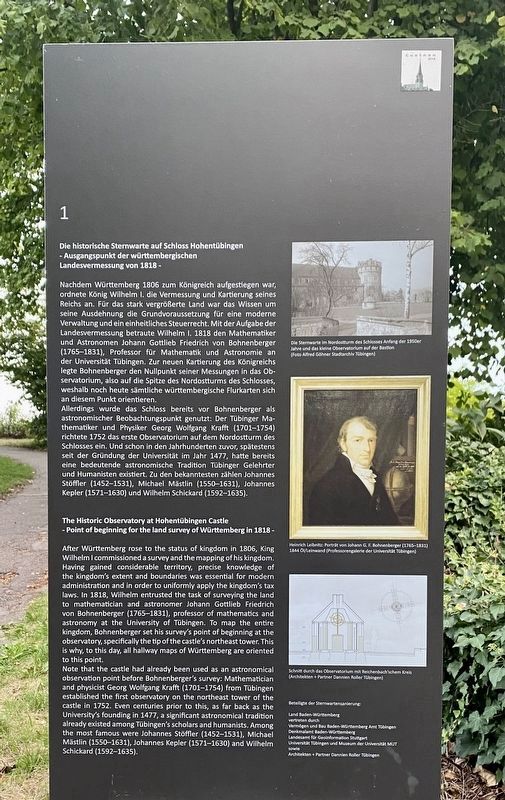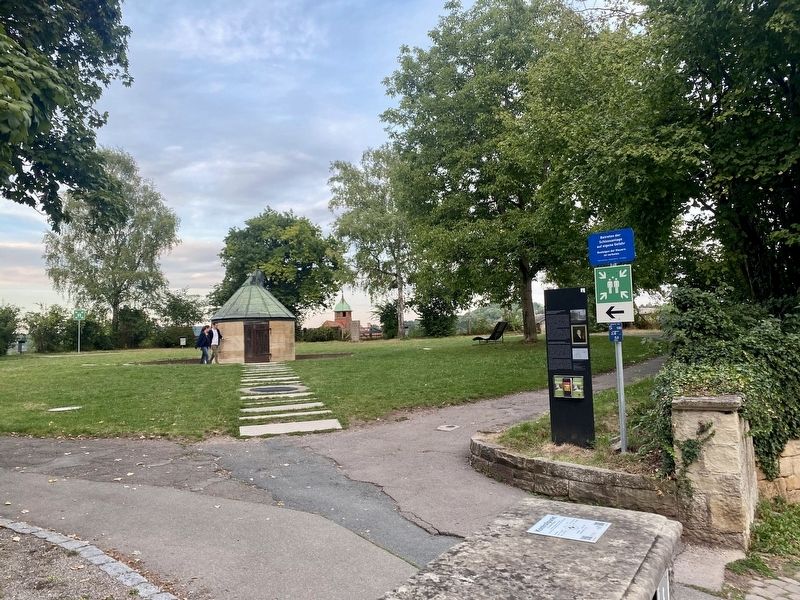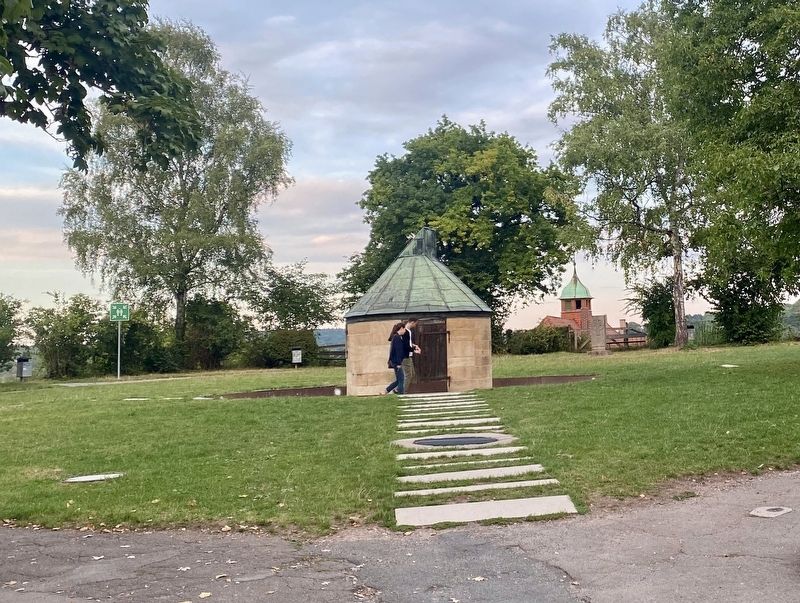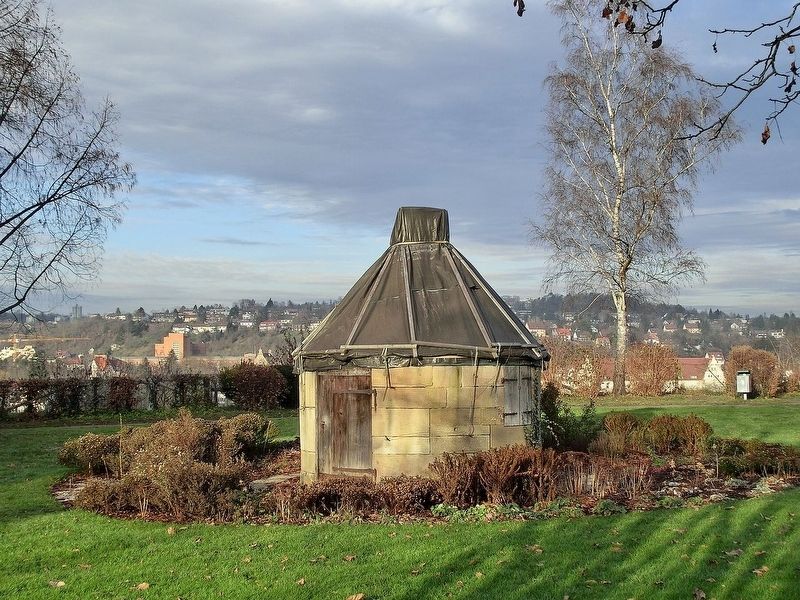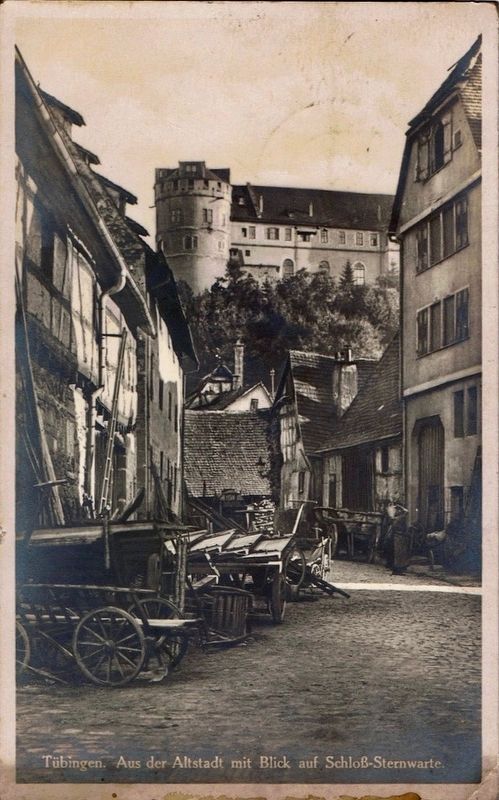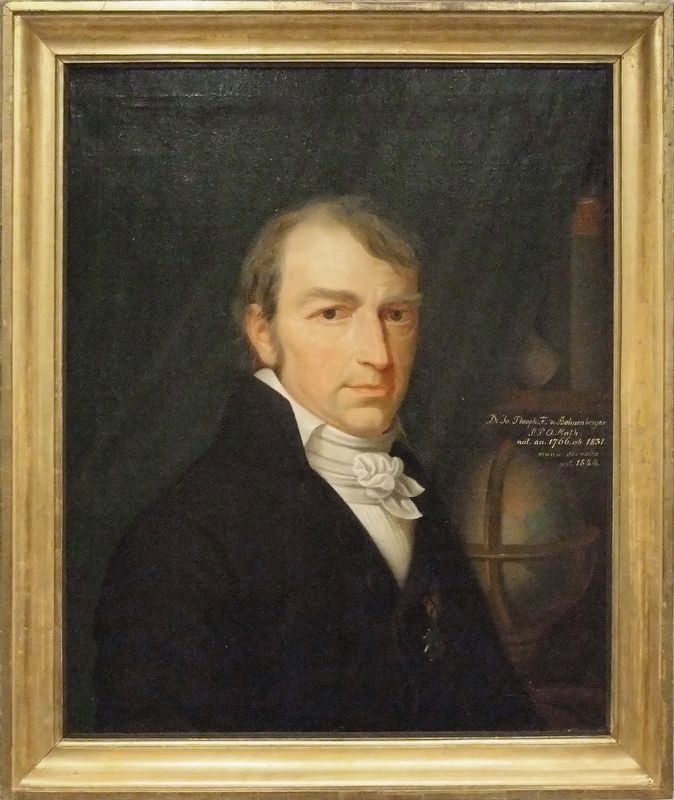Tübingen, Baden-Württemberg, Germany — Central Europe
Die historische Sternwarte... / The Historic Observatory...
Inscription.
Die historische Sternwarte auf Schloss Hohentübingen
- Ausgangspunkt der württembergischen Landesvermessung von 1818 -
Nachdem Württemberg 1806 zum Königreich aufgestiegen war, ordnete König Wilhelm 1. die Vermessung und Kartierung seines Reichs an. Für das stark vergrößerte Land war das Wissen um seine Ausdehnung die Grundvoraussetzung für eine moderne Verwaltung und ein einheitliches Steuerrecht. Mit der Aufgabe der Landesvermessung betraute Wilhelm I. 1818 den Mathematiker und Astronomen Johann Gottlieb Friedrich von Bohnenberger (1765-1831), Professor für Mathematik und Astronomie an der Universität Tübingen. Zur neuen Kartierung des Königreichs legte Bohnenberger den Nullpunkt seiner Messungen in das Observatorium, also auf die Spitze des Nordostturms des Schlosses, weshalb noch heute sämtliche württembergische Flurkarten sich an diesem Punkt orientieren.
Allerdings wurde das Schloss bereits vor Bohnenberger als astronomischer Beobachtungspunkt genutzt: Der Tübinger Mathematiker und Physiker Georg Wolfgang Krafft (1701-1754) richtete 1752 das erste Observatorium auf Nordostturm Schlosses ein. Und schon in den Jahrhunderten zuvor, spätestens seit der Gründung der Universität im Jahr 1477, hatte bereits eine bedeutende astronomische Tradition Tübinger Gelehrter und Humanisten existiert. Zu den bekanntesten zählen Johannes Stöffler (1452-1531), Michael Mästlin (1550-1631), Johannes Kepler (1571-1630) und Wilhelm Schickard (1592-1635).
-Point of beginning for the land survey of Württemberg in 1818-
After Württemberg rose to the status of kingdom in 1806, King Wilhelm I commissioned a survey and the mapping of his kingdom. Having gained considerable territory, precise knowledge of the kingdom's extent and boundaries was essential for modern administration and in order to uniformly apply the kingdom's tax laws. In 1818, Wilhelm entrusted the task of surveying the land to mathematician and astronomer Johann Gottlieb Friedrich von Bohnenberger (1765-1831), professor of mathematics and astronomy at the University of Tübingen. To map the entire kingdom, Bohnenberger set his survey's point of beginning at the observatory, specifically the tip of the castle's northeast tower. This is why, to this day, all hallway maps of Württemberg are oriented to this point.
Note that the castle had already been used as an astronomical observation point before Bohnenberger's
survey: Mathematician
and physicist Georg Wolfgang Krafft (1701-1754) from Tübingen
established the first observatory on the northeast tower of the
castle in 1752. Even centuries prior to this, as far back as the
University's founding in 1477, a significant astronomical tradition
already existed among Tübingen's scholars and humanists. Among
the most famous were Johannes Stöffler (1452-1531), Michael
Mästlin (1550-1631), Johannes Kepler (1571-1630) and Wilhelm
Schickard (1592-1635).
(Marker Number 1.)
Topics. This historical marker is listed in this topic list: Science & Medicine. A significant historical year for this entry is 1818.
Location. 48° 31.173′ N, 9° 3.081′ E. Marker is in Tübingen, Baden-Württemberg. Marker can be reached from Burgsteige. Touch for map. Marker is in this post office area: Tübingen BW 72070, Germany. Touch for directions.
Other nearby markers. At least 8 other markers are within walking distance of this marker. Regina Burckhardt-Bardili and Andreas Burckhardt (about 90 meters away, measured in a direct line); Haagtor / Haag Gate (about 150 meters away); Zerstörung der kommunalen Demokratie / Destroying the Municipal Democracy (about 180 meters away); Hermann Kurz (about 210 meters away); Kornhaus (about 240 meters away); Ein Schöpfbrunnen aus der Unterstadt / A Well from the Lower Part of Town (approx. 0.2 kilometers away); Philipp Melanchthon
(approx. 0.3 kilometers away); Former Dominican Building (approx. 0.3 kilometers away). Touch for a list and map of all markers in Tübingen.
More about this marker. From Burgsteige, enter through the castle portal, then proceed about another 50 meters, where there will be a gate or entrance to the park. The marker is at the right of the entrance, and the observatory itself will be visible another 25 meters into the park.
Regarding Die historische Sternwarte... / The Historic Observatory.... Note that at the end of the first paragraph in English there is a mis-translation of the the word "Flurkarten". Flurkarten would be better translated as "field maps", not "hallway maps".
Also see . . . Bohnenberger Observatory (Museum of the University of Tübingen). A short, clarifying history of Bohnenberger Observatory (i.e., the one in the park - not the one in the Castle's northeast tower).
Excerpt on the New Observatory on the Bastion (i.e., the one visible in Pictures 2-4): In order to improve the technical gear for the observatory, Johann Gottlieb Friedrich Bohnenberger ordered one of the most modern angle meters of his time in approximately 1812, a large repetitive circle from the company Reichenbach & Utzschneider in Munich. Bohnenberger had built the small observatory with a rotatable dome on the bastion specifically for the instrument delivered in 1814....With the new observatory on the bastion, Bohnenberger wanted to determine coordinates of celestial objects. It was the age of position astronomy with the aim to be able to describe the movement of celestial objects, for example asteroids, through star maps. Only very few of these “Reichenbach’s repetitive circles” still exist today – amongst others in Paris, Milan or Florence. The combination of the original installation site and a nearly complete instrument, as the Tübingen Ensemble presents, is globally unique and a scientific attraction."(Submitted on October 7, 2022.)
Credits. This page was last revised on October 7, 2022. It was originally submitted on October 7, 2022, by Andrew Ruppenstein of Lamorinda, California. This page has been viewed 59 times since then and 5 times this year. Photos: 1, 2, 3, 4, 5, 6. submitted on October 7, 2022, by Andrew Ruppenstein of Lamorinda, California.
